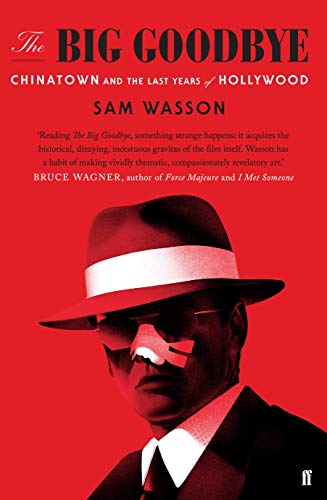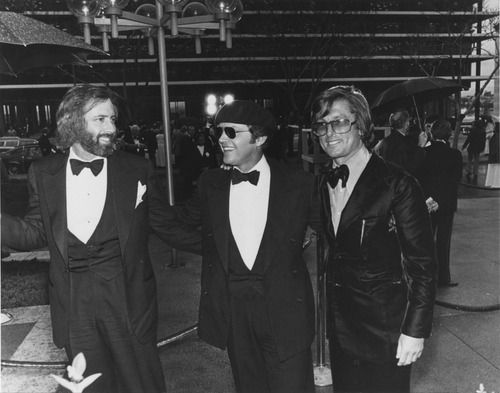The Big Goodbye: Chinatown and the Last Years of Hollywood
By Sam Wasson
Review by Rose
Noah Cross: You see, Mister Gittes, most men never have to face the fact that, at the right time, they're capable of... anything.

Wasson documents the radical changes in Hollywood filmmaking in detail, describing the way that movie deals were made in the late 1960s and early 1970s, and the changes that occurred after the completion of the film Chinatown. He demonstrates the power and decision making that led to the creation of the film, money transactions, budgets, time constrictions and the running of a studio. Wasson’s skill is his capacity to think in deep layers, as he crafts his narrative, avoiding simplistic answers and generalisations, always excavating further with his research. This book is one story, the Hollywood machine and the mechanisms of filmmaking of one historical period, within another story, the creation of the film Chinatown, within yet another, the story of Los Angeles and a cities affects on the people that lived there, and how events in this city imprinted a screenplay writer and filmmaker, eventually leading to the a film considered one of the greatest films ever made. Wasson's eye for detail and the variety in themes, make this book a fascinating read, it is highly recommended to anyone interested in filmmaking, screen writing, the trauma and corruption that existed in Los Angeles at the time Chinatown was made and the history of hollywood filmmaking.
Los Angeles, like all man-built environments, has a singular character. The landscape can seduce, with its shimmering night lights, coastal beach, sunsets and palm trees. Its soundscapes, aromas and textures can stimulate the mind and produce a myriad of emotions. A city can have an oppressive side, with isolating steely designs, disadvantaged areas and harsh structures. Deserts are a prominent feature in Los Angeles and these also have their qualities and atmospheres, that leave their imprint in the mind of the person stepping through these parched lonely lands. Danger breathes inside the fierce desert winds, that can fan treacherous fires. As man manipulates the terrain and new architectural plans are shaped, the personality of the city metamorphoses: maybe a sharper, perhaps more dynamic and flamboyant character emerges. Changes to a city may enhance, at other times, the altered cityscape may seem less approachable and remoter, a stranger we no longer recognise or trust. Robert Towne, the screenwriter, was reading Raymond Chandler and identifying with the city described in his detective books. Wasson presents us with Towne recalling his childhood Los Angeles with a heavy dose of nostalgia. What was happening to the orange groves? What exactly were the urban developers doing? What were they doing with the water? Cities live in our memory; they are powerfully connected with life experience.
Roman Polanski, the filmmaker, had two cities pencilled with pressure inside his mind. One was Kraków, Poland, torn apart by Nazi’s and the squalid horrifying Ghetto, where he witnessed daily acts of human savagery. A place where his mother was taken to Auschwitz to die. The other was Los Angeles, a place that inflamed the imagination and dreams of creative artists and writers. Wasson describes Polanski’s feelings of Los Angeles, the glorious reddened sunsets, open blue skies, the euphoria of love, the expectation of greatness, its beauty, sleek and golden. After his wife and friends were shockingly murdered, Los Angeles, distorted inside his mind, it became an atrocious character, a place that cultivated evil and obliterated innocence, a city of tarnished memories. When Polanski created a more sombre ending to the film Chinatown, he understood that life could be chaos, that one person can suffer overwhelming trauma, while the next man has a life untouched by acts of evil. What Polanski did with the last film scene, was create realism. He knew that not all evil men lose, not all men who commit atrocious acts feel guilt. Another filmmaker, with another life, would have, most likely, shaped a different ending. Wasson describes Polanski and Towne quarrelling over the story, and how their lived experiences, and personalities, constructed distinct visions. With this book, Wasson establishes that a tiny part of a person’s life experience, can be encoded into a fictional story, and be transmitted to celluloid, for generations to watch and learn from.
 Film art can convey the timbre of a screenplay writer’s life, the blistering fragment of a director’s trauma, the stormy personality of an actor. Throughout the book, profound questions arise, some intentional, some accidental, caught like tiny flames in Wasson’s skilful words. Could a city produce a certain type of killer? Are some landscapes lonelier than others in their construction? How does trauma experience affect our decision making in film and art? The book is about the intricately engineered creation of a film. It’s also a story of a vanishing Hollywood, how the film world operated, evolved and changed. It is the resonating consequence of a horrendous crime and how it touched a city, people and a film. Chinatown is about the abuse of power, it’s about a white wealthy landowner who believes he can exploit anyone he wishes, and commit any act. It’s about the darkest secret a woman could ever have. It’s about the corruption of water and a city, it’s an exploration of evil and the feeling of helplessness in the face of evil. It’s about a detective who is altered irrevocably by experience, and the knowledge that, ultimately, power and evil are not always easy to conquer.
Film art can convey the timbre of a screenplay writer’s life, the blistering fragment of a director’s trauma, the stormy personality of an actor. Throughout the book, profound questions arise, some intentional, some accidental, caught like tiny flames in Wasson’s skilful words. Could a city produce a certain type of killer? Are some landscapes lonelier than others in their construction? How does trauma experience affect our decision making in film and art? The book is about the intricately engineered creation of a film. It’s also a story of a vanishing Hollywood, how the film world operated, evolved and changed. It is the resonating consequence of a horrendous crime and how it touched a city, people and a film. Chinatown is about the abuse of power, it’s about a white wealthy landowner who believes he can exploit anyone he wishes, and commit any act. It’s about the darkest secret a woman could ever have. It’s about the corruption of water and a city, it’s an exploration of evil and the feeling of helplessness in the face of evil. It’s about a detective who is altered irrevocably by experience, and the knowledge that, ultimately, power and evil are not always easy to conquer.
Wasson creates the life stories of the three main men who created Chinatown, he begins with one landscape, Krakow, Poland and the early years of Roman Polanski's life. He moves to a second city, Los Angeles and Robert Towne, the screen writer, struggling to write a story that he believes will be his greatest achievement, and he does not want it to be just about money, it's about achieving something that surpasses economic gain. Wasson introduces Jack Nicholson, the actor who was friends with Towne, describing Nicholson's complex personality in detail, it's like looking into the life of an actor at a specific time in history. Finally, he introduces us to Robert Evan's, the producer, a man who rallied behind the creation of Chinatown, doing everything humanely possible to make sure the film was made to the directors specifications. Without him, the film would never have been made. Wasson describes how Robert Evan's was haunted by his young father's words when he worked as a dentist, a job that he did not enjoy, when he was actually a talented piano player. Due to Evan's experiences of watching his father lose in life, he was determined to live to the fullest, something he achieved. Evan's was grateful to be part of the creation of Chinatown and considered Polanski a genius. Wasson then goes on to document the invisible people who worked on the film, from the analytical set designer, the costume designer and others behind the scenes. Wasson creates an investigation into the making of a Chinatown, one feels as they read the story, that he is detective, taking us on a journey and his research is impecible.
What makes this book so interesting, is the fact that Wasson makes complex connections, between people, personalities and lived experiences and the psychological imprint of trauma. He documents the details of the parents of the three men and how Robert Towne and his relationship with his father, described as chronically mean, affected the story he wrote. He documents the trials of being a screenwriter, writers block, drug taking of the time and the way that initial ideas for the story came to Towne, piece by piece, as we see it's creation unravel, how small events in his life would all interconnect with his own personal life experiences to create a screenplay that is studied throughout the world.